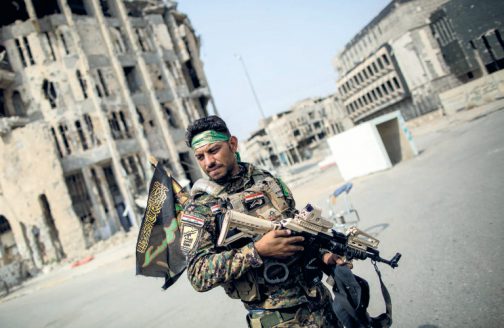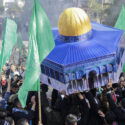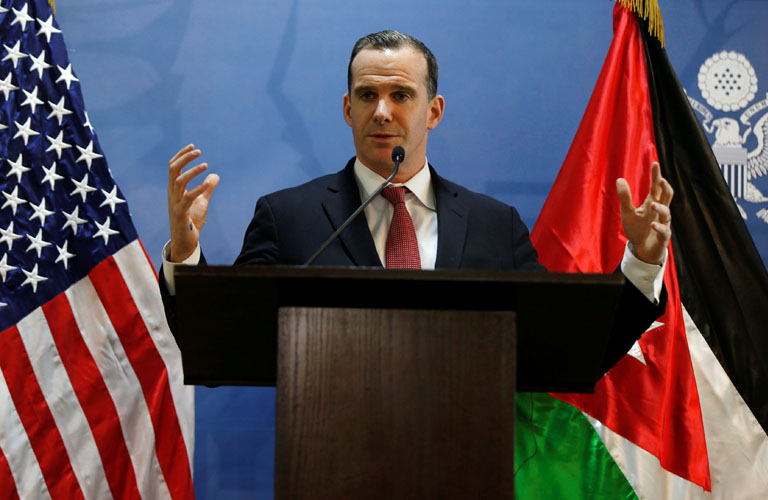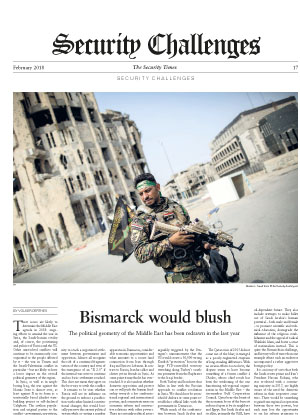The political geometry of the Middle East has been redrawn in the last year

Three issues are likely to determine the Middle East agenda in 2018: ongoing efforts to unwind the war in Syria, the Saudi-Iranian rivalry and, of course, the positioning and policies of Russia and the US. Other unresolved conflicts will continue to be enormously consequential to the people affected by it – the war in Yemen and the Israeli-Palestinian conflict in particular – but are likely to have a lesser impact on the overall political geometry of the region.
In Syria, as well as in neighboring Iraq, the war against the Islamic State is almost over, at least against IS in its form as a territorially based jihadist state-building project or self-declared Caliphate. The civilian population and original parties to the conflict – government, opposition, rebel forces – have all suffered enormous losses. The government of President Bashar al-Assad has re-established control over some two-thirds of the country. Given its ongoing reliance on the massive support of Russia, Iran and Iranian-sponsored forces to regain and hold territory it had previously lost either to oppositional forces or to IS, it is much weaker today than in 2011. If any party has won the war, it is Russia, not the government and certainly not the rebels.
The opposition has not been totally defeated, but it has certainly lost the war. Armed opposition groups have largely been relegated to four de-escalation areas. Altogether, opposition-held territory accounts for less than 10 percent of Syria’s total area. More than one-fifth of Syria remains under the control of the Kurdish PYD (Party of Democratic Union), which is less interested in who rules Damascus than how much autonomy it can achieve for Syria’s majority-Kurdish areas in the north.
Most of the relevant regional and international players tend to agree that the end of the war against IS provides an opportunity to reach a negotiated settlement between government and opposition. Almost all recognize the risk of a continued fragmentation of the country and even of the emergence of an “IS 2.0” if the internal war were to continue and no basic settlement reached. This does not mean they agree on the best way to settle the conflict.
It remains to be seen whether Russia will use its influence on the ground to enforce a pacification with rather limited constitutional changes; this would basically preserve the current political system while co-opting a number of leaders from the political and armed opposition. Alternatively, UN efforts to engage the parties in real peace negotiations will eventually lead to a more genuine form of power sharing, a new constitutional reality, significant guarantees for political and human rights, and credible, UN-supervised presidential and legislative elections. Given the structure of influence and leverage, the former seems more achievable, but also more brittle. And the latter can only succeed if Russia, the US and the EU, but also Iran, Saudi Arabia, Turkey and smaller but more aggressive players like Qatar, actively supported it.
Moreover, the Syria conflict remains linked to the second issue that defines current regional dynamics: the Saudi-Iranian struggle for regional hegemony. Both Riyadh and Tehran tend to see the other as the main competitor for regional leadership and thus a threat.
Saudi Arabia remains the main sponsor of the Syrian opposition, and Iran the main regional backer of Assad. Tehran is unlikely to cede its enormous political investment in Syria, its strong influence on the government and security apparatus in Damascus, considerable economic opportunities and what amounts to a secure land connection from Iran through Iraq and Syria to Lebanon. In contrast to Russia, Iran has allies and clients yet no friends in Syria. At some point it may find it has overreached. It is also unclear whether domestic opposition and protest can or will push the Iranian leadership towards a less confrontational regional and international posture, and concentrate more on economic reform and constructive relations with other powers. There are certainly political actors in Iran who would favor such an adjustment, yet others who would rather try to compensate any sign of domestic weakness with a more aggressive foreign-policy stance.
Ankara and Tehran do not see the world through the same lens, but they do share similar threat perceptions. Both want to make sure not to end up as junior partners to a Russian-planned and Russian-managed settlement of the conflict in Syria. They want to quash Kurdish aspirations for independence or autonomy in Iraq, and at least Turkey is determined to prevent the emergence of a contiguous zone along the Syrian-Turkish border, which would be dominated by the PYD (the sister organization of Turkey’s banned PKK, or Kurdish Workers Party). Add to this Ankara’s increasing lack of trust with regard to the US, particularly since Washington made the PYD its main military partner in Syria. While Turkey’s recent military incursion into the northern Syrian district of Afrin was driven by the long-held goal of degrading and ideally eliminating PYD control over this isolated Kurdish enclave on the western edge of the Turkish-Syrian border, it was arguably triggered by the Pentagon’s announcement that the US would create a 30,000-strong Kurdish “protection” force in the large PYD-controlled territory stretching along Turkey’s southern perimeter from the Euphrates to the Iraqi border.
Both Turkey and Iran have thus fallen in line with the Russian approach to conflict resolution in Syria. We should not be astonished if Ankara at some point re-establishes official links with the government in Damascus.
While much of the confrontation between Saudi Arabia and Iran has played out in Syria over the past seven years, the two countries have been geopolitical rivals for much longer, since even before Iran became the Islamic Republic. But none of the features of this rivalry is an unchangeable given. As regards Syria, Saudi Arabia no longer opposes a settlement that would leave Assad in power, but wants to prevent what it would regard as an Iranian takeover. There could be room for compromise here.
However, since his elevation to minister of defense in 2015 and crown prince in 2017, Muhammad bin Salman has been the driving force behind a highly assertive and strongly anti-Iranian regional policy. This includes an utterly destructive war in Yemen, which seems far from reaching either a military resolution or a negotiated settlement and may have encouraged much of the Iranian presence and influence the Saudi leadership claims to be fighting there. Similarly, the Saudi leadership may have helped Iran to strengthen its reputation in Lebanon by trying to force Lebanon’s Prime Minister Saad Hariri to resign under rather murky circumstances while in a TV studio in Riyadh.
The Qatar crisis of 2017 did not come out of the blue; it emerged as a poorly engineered eruption of long-standing differences. With no serious efforts to resolve it, the dispute seems to have become something of a frozen conflict à l’Arabe, whose chief result has been the weakening of the one functioning sub-regional organization in the Middle East – the six-member Gulf Cooperation Council. Qatar bears the brunt of the economic losses of the boycott enforced upon it by its neighbors and Egypt. But Saudi Arabia and its allies, primarily the UAE, have been ineffective in enforcing their will on their smaller neighbor. Rather than scaling down its relations to Iran, Doha became dependent on Iranian air space and imports, upgraded the relationship and invited Turkey to enlarge its military presence in the Emirates.
Saudi Arabia’s increasingly assertive regional policy should not be seen in isolation from the ambitious and much-needed efforts of the crown prince to embark on a form of belated nation-building in a state that, since its inception, has defined itself in religious terms more than in national terms.
These efforts include the attempt to mobilize younger generations and to reform the country’s society and economy under a wide-ranging “Vision 2030” program, which aims to prepare Saudi Arabia for a less oil-dependent future. They also include attempts to make fuller use of Saudi Arabia’s human potential – both male and female – to promote scientific and technical education, downgrade the influence of the religious establishment and the appeal of radical Wahhabi Islam, and foster a sense of nationalism instead. This is quite the Bismarckian challenge, and history tells of more than one example where such an endeavor accompanied a rather aggressive foreign policy.
It is an irony of sorts that both the Saudi crown prince and Iran’s President Hassan Rohani, who was re-elected with a convincing majority in 2017, are highly aware of the need for domestic reform in their respective countries. There would be something to gain from regional cooperation between these two powers, but each may lose the opportunity to see his reform programs to fruition due to costly external confrontations.
While his regional policies have thus far brought mixed results at best, Mohammad bin Salman was able to boost his domestic and regional posture by securing the personal support of US President Donald Trump and a US acknowledgement of Saudi’s lead role in a loose coalition of Arab states. It was no great feat for the crown prince to align himself with the Trump administration’s two priorities in the region: the fight against terrorism, by whichever definition, and a rollback, as it were, of Iran.
It is small wonder that Saudi, Emirate, Israeli and other regional leaders are eager to inject the Trump administration’s more hardline stance on Iran into their own political projects. Other allies of the US – particularly Turkey – have become more skeptical of a US approach that seems to put military considerations of expediency above alliance considerations. By de-emphasizing diplomacy and making rash policy such as the recognition of Jerusalem as Israel’s capital, Trump has been undermining the America’s role as the ultimate mediator, which almost all regional states have relied upon irrespective of Washington’s never-hidden pro-Israeli bent.
Russia, in contrast, seems to have learned something from previous US-policy books for the Middle East, particularly in presenting itself as an interlocutor for all while making no secret of its strategic interests. It is cooperating with Iran to stabilize the Assad government, but also received the Saudi monarch before even Washington had. It is Syria’s most important military ally yet continues to demonstrate its excellent relationship to Israel, not least through the well-publicized visit of its defense minister to Tel Aviv. There have even been suggestions that Russia may be acceptable as a mediator on Jerusalem. And whereas the US has been ignoring – at least in Ankara’s eyes – some of Turkey’s main national security priorities, Russia has been able to restore a relationship that was on the verge of war in 2015.
Moscow may not come across as a benign actor. The brazen announcement by Russia’s ministry of defense that the Russian military had used the war in Syria to test “more than 160 modern and prospective types” of weaponry will certainly be seen as utterly cynical by members of Syria’s opposition. Russia may appear as a brute – but it is a brute with a plan both to end the war in Syria and to broaden its reach across the region.
In contrast, while militarily spearheading the anti-IS coalition, Washington has become somewhat of a diplomatic bystander in the region. In 2015 and 2016, US Secretary of State John Kerry and the Russian Foreign Minister Sergei Lavrov co-chaired four ministerial meetings of the International Syria Support Group, which helped launch the UN-led intra-Syrian talks in Geneva and succeeded in establishing a first short-lived cessation-of-hostilities. In 2017, the US was content with its observer status in the Russian-led Astana talks. Even America’s new Syria policy, as laid out by Secretary of State Tillerson in January 2018, has confirmed the military’s lead on Syria. It calls for an open-ended US military presence in the country even after the defeat of IS, mainly to deny an expansion of Iranian influence, but shows no ambition to reassume a lead political role with regard to Syria’s future.
Observers may be forgiven for seeing similarities between this lesser US role and the position the EU has occupied for quite some time, minus the preparedness to dump substantial amounts of money into regional schemes. It is yet unclear whether the EU, most probably under French leadership, would be able to fill some of the diplomatic void created by America’s absence in the region; given the habit of Middle East leaders to balance their external relations rather than leave the politics and diplomacy to one of the great powers, it is likely there would be takers for such a European role.
VOLKER PERTHES
is director of the German Institute for International and Security Affairs (SWP) and its executive chairman of the board.




